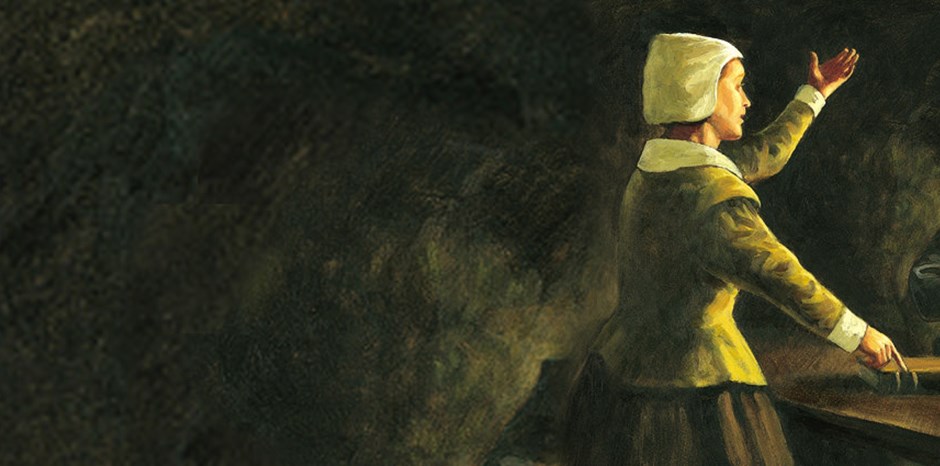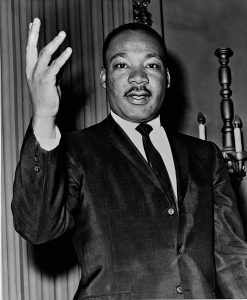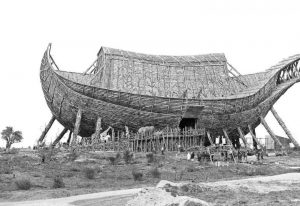For centuries women have fought against numerous injustices forced upon them because of their gender. Some of these injustices include the right to be seen as an equal to men, the right to vote, and the right for equal pay, along with many more. Although women have succeeded in breaking down some of these barriers, there are still many inequalities being fought today. During the seventeenth century, there was one woman in particular who battled in opposition to social injustice: Anne Hutchinson. This article is about the life of a brave woman who opposed an unfair law forbidding men and women from freely practicing their religion, and who also challenged the preposterous roles women were limited to in the religious community.

Anne Hutchinson, maiden name Anne Marbury, was born July 20, 1591, in Alford, England. She was the daughter of a midwife and a Cambridge scholar who published many unorthodox religious texts. In fact, Francis Marbury’s teachings were banned from where he was a teacher, at Saint Wilfred’s School in Alford. After vigorous pleading, Marbury was able to have the ban lifted, and he began teaching again in 1602. 1 Perhaps this is where Anne inherited her tenacious spirit to express her opinion. In 1605, at the young age of fourteen, Anne and her family moved to London for her father’s new position as rector of Saint Martin’s Vintry, leaving behind Anne’s boyfriend, a tailor named William Hutchinson. After the death of Anne’s father in 1611, Hutchinson moved to London to be with Anne; the next year the two were married. That same year, the newlywed bride returned to Alford where her husband continued his tailor business, and Anne followed in her mother’s footsteps as a midwife. Anne and William went on to raise thirteen children together in Alford. 2
In 1612, newly ordained Puritan minister John Cotton began preaching at Saint Botolph’s Church in Boston, Lincolnshire, not far from Alford where Anne Hutchinson resided. His unique approach greatly intrigued Hutchinson. 3 Cotton’s preaching and his understandings of religion reminded Anne of her father’s teachings. Anne enjoyed Cotton’s work so much, that in 1633, when Cotton immigrated to New England, Anne convinced her husband to move there as well. In 1634, Anne and her family made the long transition to Massachusetts. 4
The following year, in 1635, Hutchinson began holding weekly gatherings in her home to discuss minister Cotton’s sermons. Anne and her followers addressed their beliefs of sheer grace as opposed to the Calvinist theological viewpoint of predestination. Hutchinson and her followers believed that God alone grants salvation to whomever He believes is worthy of His grace, without human interaction. The clergy in New England taught that people could gain God’s grace by willingly performing various covenant conditions, such as performing good deeds, reciting prayers, attending church, along with other forms of religious practice. 5 Anne’s critics called her teachings Antinomianism. The Greek word is translated as “hostile to the law.” Anne provoked the colony leaders by proclaiming that members of their clergy who had not undergone a conversion experience had no authority to be held responsible for the spiritual offices of the colony. She also brought attention to the common yet unfair assumptions of women’s roles within Puritan society. 6 Anne’s following continued to grow, and it became so significant that in the 1636 governor’s election, the colony prevented the reelection of the current governor John Winthrop, and elected Sir Henry Vane the Younger into office. Sir Henry was an outspoken supporter of Anne’s movement, and he was a strong supporter of the anti-Winthrop movement.

Anne’s rising popularity caused three major problems for the colonial leaders. First, Anne’s gatherings paralleled preaching, which was strictly limited to those with a licence, and was absolutely forbidden to women. Second, the New England clergy was putting forth great effort in order to establish a unified church. Anne’s teachings contradicted their efforts. Third, Anne’s supporters consisted of both men and women. This act challenged the status quo of men being the only influential figures within society. 7 Never before had a woman caused so much trouble for authority figures, nor had a woman been the leader of a huge support of individuals.
The turning point of Anne’s momentum occurred during the governor election in May 1637, when former governor John Winthrop was reelected to office. It is not difficult to understand why Winthrop put Hutchinson on trial for heresy when he took office in November. 8 Winthrop was desperate to regain social order within the colony. The trial was held publicly to make an example out of Hutchinson, to show what happens to those who oppose the church and therefore oppose the colonial leadership. Anne surprised many with her witty banter and intellectual remarks. She defended herself quite impressively, proving her knowledge of the Bible and religious laws, and also by providing evidence demonstrating that her accused charge was based on more circumstantial evidence than proven facts of illegal activity. For example, the court tried to charge her with sedition, or an action suggesting discontent or rebellious actions against the government. Hutchinson made it clear that expressing opinions and holding conversations within a women’s meeting was not an illegal act. The statements made within those meetings were confidential because they were held in the privacy of her home. The spectacle of a self-educated woman verbally battling a governor who was a Cambridge scholar on an equal level was unheard of. Despite Hutchinson’s efforts, she was still convicted and banished from the colony. Anne was at a disadvantage from the start with civil officers, elected deputies, and clergymen represented as the jury in the trial. 9 After the verdict, Anne, her family, and a few loyal followers migrated to Rhode Island for a short while before settling in the Dutch colony of New Netherlands, which subsequently became New York. In 1643, Anne and her family became victims of an Indian uprising and were killed during the attack.

Anne Hutchinson is seen as one of the first female feminist who fought for religious freedom. Anne’s actions represent a right established to us as Americans in 1791. The first amendment to the Constitution established the freedoms of religion, assembly, speech, press, and petition. Anne’s reasons for refusing to conform to colonial authorities were reasonable and respectable. She was not the only person to fight for individual freedoms; but her courageous start led the way for others to fight against injustices too.
- John R. Holmes, “Anne Hutchinson,” Salem Press Biographical Encyclopedia (January 2016), 1. ↵
- Holmes, “Anne Hutchinson,” 1. ↵
- Francis J. Bremer, “John Cotton,” Salem Press Biographical Encyclopedia (2016), 1. ↵
- Holmes, “Anne Hutchinson,” 1. ↵
- James F. Cooper, Jr., “Anne Hutchinson and the ‘Lay Rebellion’ against the Clergy,” The New England Quarterly, Inc 61, no. 3 (September 1988): 382-383. ↵
- Alan Brinkley, American History, 15th ed., vol. 1: to 1865 (2 Penn Plaza, New York, NY 10121: McGraw Hill Education, 2015), 45. ↵
- Holmes, “Anne Hutchinson,” 1. ↵
- Alan Brinkley, American History, 45. ↵
- Lisa McGunigal, “The Criminal Trial of Anne Hutchinson: Ritual, Religion, and Law,” Mosaic: A Journal for the Interdisciplinary Study of Literature 49, no. 2 (June 2016): 1-8. ↵



133 comments
Kayla Braxton-Young
I’ve never actually read anything like this piece before, but I thought it was excellent. I learned a lot about a person I had never heard of thanks to the wealth of information in this post. You can tell from reading this article that Anne Hutchinson was a leader who never gave up. She was going to battle tirelessly for what was rightfully hers because she had power and would use that power. A leader, she is. Some of the quotes you included were quite forceful and compelling, which made reading the piece much more powerful. This article was very useful, and you made some excellent word choices.
Rigel
Interesting article! I have never heard of Anne Hutchinson before this article, so this is new information to me. Your article does a wonderful job at explaining her early life and how it matches to herself as a young woman preaching for equal rights. It is amazing that she was able to defend herself against a Cambridge scholar on an equal level and proving her knowledge of the bible and religious laws.
Victorianna Mejia
This article was such a great read! It was beautifully written. I had no idea who Anne Hutchinson was before reading this. She was a brave woman for her time, and I appreciate the effort she made for a progressive community. Her courage while representing herself in court is a beautiful act of resistance to inequality and the fight for religious freedom. Again, great article! Loved it!
Vanessa Preciado
Hello Mia! I am very impressed by your article. There is so much information in this small article , which is great! I already feel like I gained a lot of knowledge about Anne Hutchinson. To begin with I did not know much about this woman, but it’s nice to know she stood up for women and men to be able to practice religion at their own convenience in their own spaces. Also the biggest applause from me to her was that she also stood up for women being treated equal to men on certain right’s as well. Also, I do like the picture you chose, I believe it clearly speaks for itself , just seeing Anne up there doing her thing, Great job!
Jorge Martinez
I had never heard of Hutchinson before reading this article. I personally loved the fact that she was able to defend herself in court. It goes to show that the well educated can always form great arguments. It is a shame that she got banished, which resulted in her death. I think anyone can be a leader and it is shame we lost a great mind in a tragedy.
Gabriella Parra
I had never heard of Anne Hutchinson before, but I have heard of many women who have been in her position. Just like in the 17th century, in religious circles it is common for women to be accused of going against religious texts for giving their interpretation of scripture. It is almost comforting to know that, even though Anne was banished from her original colony, she found refuge in New York. She was able to make her way in the world despite prejudices.
Jace Nicolet
In the 17th century, a woman named Anne was born. She was not allowed to do much like vote, pay, or even have equal pay to men at the time. She always practiced religion and grew up in England. She raised many children and was the first woman to fight for religious freedom. She believed god grants gifts to whoever he believes deserves it. She ended up with many supporters and people following her footsteps to Religious Freedom.
This connects to the themes in class By going over the harsh lives that some people had due to religion and beliefs back in the 17th century. it’s also conveys the conflict many leaders had with opposing religions and human rights. This reminds me of the story of Martin Luther and how he called out the church and referred back to the Bible 4 facts remember to light even if it put him in danger.
The Author does a great job telling the story in a way that it keeps me intrigued to find out what happens next and has me on the edge of my seat for the story. She also does a good job at providing paintings from the time period so that I can get a glimpse of how they were living and the communities being talked about in this article.
Alia Hernandez Daraiseh
Mia Diaz did a wonderful job at telling the moving story of Anne Hutchinson. With thorough research and details, Diaz wrote in such a way where it moved me and made me more interested in reading more. It is sad, knowing that women to this day still have to fight for basic human rights, and that Hutchinson was banished for simply wanting to practice religion freely. I believe things like this were meant to happen, she was the start of a movement, one of the reasons why we have the first amendment.
Serenity Kamenski
Your writing was very nicely done and truly shed light on who Anne Hutchinson was and what she had accomplished. I can’t get over this line you wrote: “self-educated woman verbally battling a governor who was a Cambridge scholar on an equal level”. It might not be the most significant action a woman has done to stand up for her rights, but it sure was powerful to know that despite being self-educated, Anne Hutchinson still was able to hold her own against a scholar who should be on a higher level. It really paints her in a way that stays true to her title the ” first feminist”.
Velma Castellanos
I have never heard about Anne Hutchinson until now. Now that I have read this, I have more knowledge about this figure in history. She had a big impact on us and now we have freedoms that we have today. She played a huge role in starting the conversation of freedom of religion and equality amongst women. I admire her for standing her ground even though she knew she would get criticized but still fought for what she believed in. Overall she was a remarkable person who was inspiring. You did well on this article and should be proud of yourself.